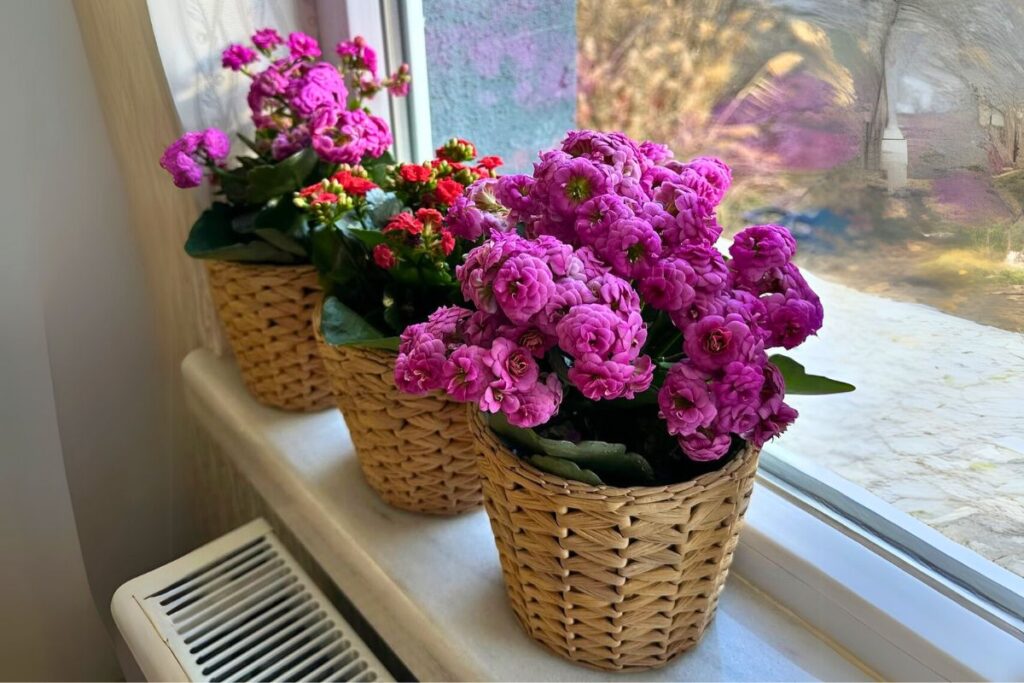Kalanchoe plants are a popular choice for indoor gardening, thanks to their vibrant flowers and succulent foliage. These hardy plants are not only beautiful but also relatively easy to care for, making them ideal for both novice and experienced plant enthusiasts. In this guide, we’ll explore everything you need to know to successfully grow and care for kalanchoe plants indoors.

Contents
Choosing the Right Location
Kalanchoe plants thrive in bright, indirect light. They can tolerate some direct sunlight, but too much can scorch their leaves. Place your plant near a window where it can receive plenty of filtered sunlight. If natural light is limited, you can use a grow light to supplement its needs. Aim for about 4-6 hours of bright, indirect light daily to ensure healthy growth and vibrant blooms.
Maintaining Proper Temperature and Humidity
Kalanchoe plants prefer warm environments, similar to their native tropical habitat. Keep your plant in a room with temperatures ranging from 60-75°F (15-24°C). They can tolerate lower humidity levels typical of most indoor environments, so there’s usually no need for additional humidity. However, avoid placing your kalanchoe near drafty windows or heating vents, as sudden temperature fluctuations can stress the plant.
Watering Wisely
Proper watering is crucial for the health of your kalanchoe plant. These succulents prefer well-draining soil and should be watered thoroughly but infrequently. Allow the soil to dry out completely between waterings, and then water deeply until excess water drains out of the bottom of the pot. Overwatering can lead to root rot, so it’s better to err on the side of underwatering. During the growing season (spring and summer), you may need to water more frequently, while in the dormant period (fall and winter), reduce the frequency.
Soil and Fertilizing
Kalanchoe plants thrive in well-draining, nutrient-rich soil. A cactus or succulent potting mix works well, as it provides the right balance of moisture retention and aeration. If you’re using regular potting soil, consider adding sand or perlite to improve drainage. Feed your plant with a balanced, water-soluble fertilizer diluted to half strength every 4-6 weeks during the growing season. Reduce or stop fertilizing during the dormant period to prevent nutrient buildup.
Pruning and Maintenance
Regular pruning helps maintain the shape and health of your kalanchoe plant. Remove any dead or faded flowers to encourage new blooms and keep the plant looking its best. You can also trim back any leggy stems to promote a bushier appearance. Kalanchoe plants can tolerate moderate pruning and will often respond with vigorous new growth.
Styling Your Kalanchoe Plant
Kalanchoe plants are versatile and can be styled in various ways to enhance your indoor decor. Here are some ideas to help you create a stunning display:
- Tabletop Accent: Place your kalanchoe in a decorative pot and position it on a tabletop or desk. Its vibrant flowers and succulent leaves will add a pop of color to your workspace or living area.
- Hanging Baskets: Use hanging baskets to showcase the plant’s trailing stems. This not only saves space but also adds a dynamic, vertical element to your decor.
- Grouping with Other Plants: Combine your kalanchoe with other indoor plants to create a lush, green oasis. The contrasting textures and colors can add visual interest to your plant collection.
- Creative Containers: Choose pots and containers that complement your interior design. The contrast between the plant’s vibrant blooms and stylish pots can enhance the overall aesthetic.
Propagation Techniques
Propagating kalanchoe plants is relatively easy and a great way to expand your collection or share with friends. Here are two common methods:
Stem Cuttings
- Choose a healthy stem with several leaves.
- Using clean scissors or pruning shears, cut a 4-6 inch section just below a node.
- Allow the cutting to callous over for a few days before planting it in well-draining soil.
- Water sparingly until roots develop, then care for the new plant as usual.
Leaf Cuttings
- Gently remove a healthy leaf from the plant.
- Allow the leaf to callous over for a few days.
- Place the leaf on top of well-draining soil, ensuring the calloused end is in contact with the soil.
- Water sparingly until roots develop, then care for the new plant as usual.
Dealing with Pests and Diseases
Kalanchoe plants are relatively resistant to pests and diseases, but they can occasionally fall victim to aphids, mealybugs, and spider mites. Regularly inspect your plant for signs of pests and treat any infestations promptly with insecticidal soap or neem oil. Maintaining proper care practices and a clean environment can help prevent most common issues. Yellowing leaves can indicate overwatering or inadequate light, so adjust your care routine as needed.
Troubleshooting Common Issues
- Yellowing Leaves: Often a sign of overwatering or poor drainage. Check the soil moisture and ensure the pot has adequate drainage.
- Brown Leaf Tips: This can indicate low humidity or underwatering. Increase humidity levels and adjust your watering schedule.
- Leggy Growth: Lack of light can cause leggy growth. Move the plant to a brighter location or provide supplemental light.
Growing kalanchoe plants indoors can be a rewarding experience, adding a touch of vibrant color and charm to your home. By following these care tips and paying attention to your plant’s needs, you’ll be well on your way to enjoying a lush and healthy kalanchoe plant. Happy planting!
